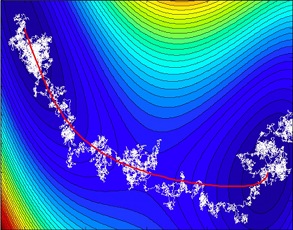Sampling techniques for rare events

Dynamical systems are often subject to random perturbations or noise. Even when the noise amplitude is very small, it has a profound influence on the dynamics on the appropriate time-scale. At a first sight one might think that this influence happens at such a long time-scale that it is rarely of practical importance. That this is an incomplete view may be understood by noticing that most physical processes will not happen at zero temperature when thermal noise is absent. In reality nature presents one with a very wide range of temporal scales. The small noise induces events which are rare with respect to the internal clock of the system, but this clock can be very fast, and the processes of interest to our daily lives are mostly on the order of seconds or longer. This leaves plenty of room for rare events caused by thermal noise to make their appearance. In fact, phenomena like nucleation events during phase transitions, chemical reactions, conformation changes of biomolecules, bitable behaviors in genetic switches, or regime changes in climate are just a few examples of rare events among many others.
Traditionally the methods of choice for a quantitative understanding of the effect of noise has been Monte Carlo or direct simulation of Langevin equations. When the noise is small, which is the case of interest here, these methods become prohibitively expensive, due to the presence of two disparate time-scales: the time-scale of the deterministic dynamics and the time-scale between the rare events caused by the noise. Noticing this difficulty, alternative theories and numerical methods have been proposed.
This section contains the works where we developed theoretical tools and their numerical counterparts to identify the pathways of rare events in complex systems and estimate their rate of occurrence and associated free energy. These works include some reviews; papers on transition path theory (TPT), a new theoretical framework to go beyond large deviations theory (LDT) in situations where entropic effects dominate; papers on the string method and the minimum action method, which are numerical techniques based on LDT and TPT to identify the transition pathways of rare events in complex systems; papers on transition state theory, in which an original viewpoint is taken on this well-known theory; and finally papers on various sampling techniques for the Boltzmann-Gibbs probability distribution with or without constraints, or its marginal in a few collective variables to compute the free energy associated with these variables.